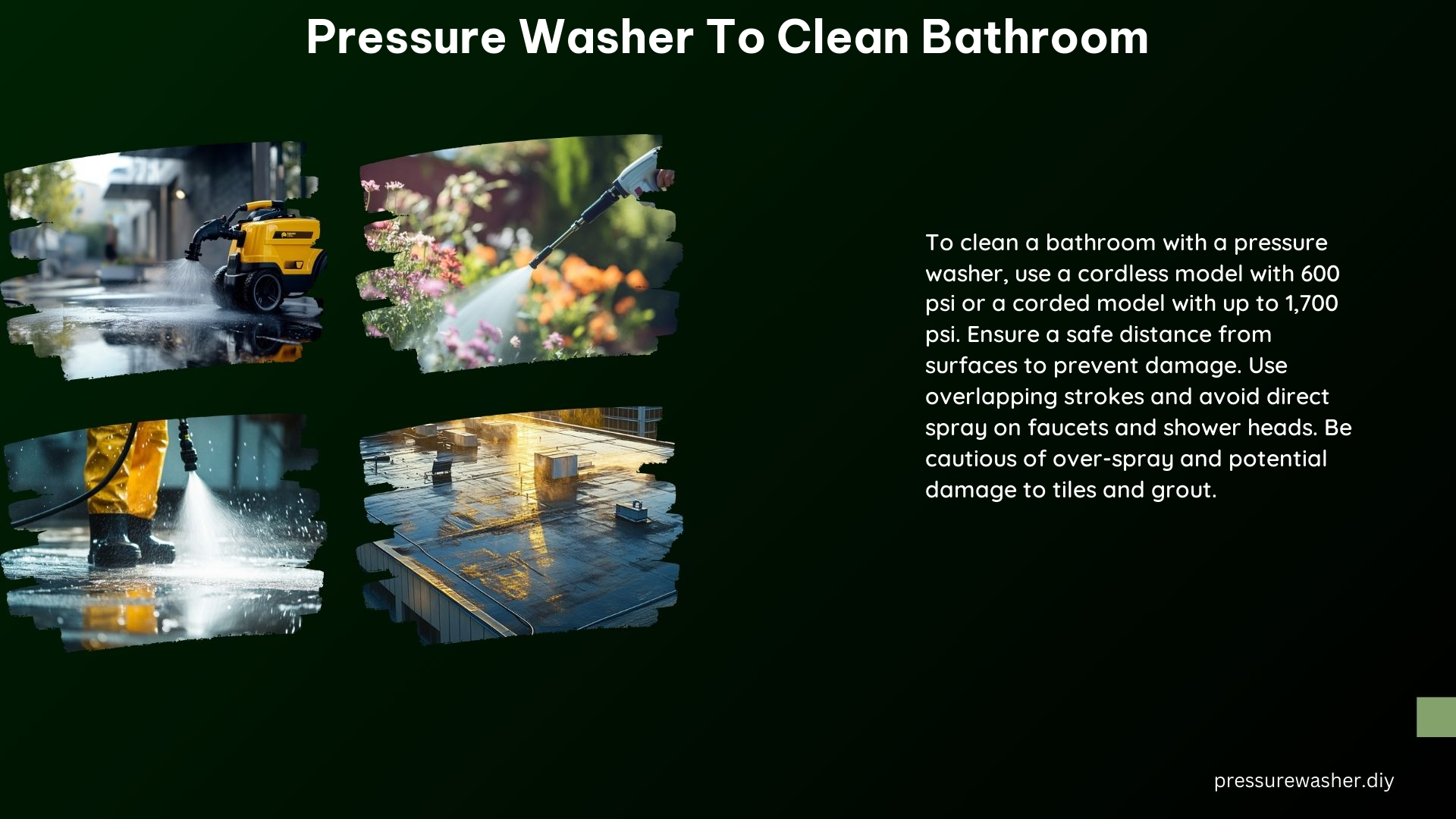Cleaning a bathroom with a pressure washer can be an efficient and effective way to remove stubborn dirt, grime, and mildew. However, it’s crucial to use the right equipment and follow the proper steps to avoid damaging the delicate surfaces and fixtures in your bathroom. This comprehensive guide will provide you with the necessary information to safely and effectively use a pressure washer to clean your bathroom.
Necessary Equipment
Pressure Washer
When selecting a pressure washer for indoor use, it’s essential to choose a model with a pressure rating of around 1,700 PSI (Pounds per Square Inch) or lower. This lower pressure range is crucial to prevent damage to your bathroom surfaces, such as tiles, porcelain, and fixtures. Cordless pressure washers are particularly well-suited for indoor use, as they offer lower pressure and increased safety compared to their corded counterparts.
Hose and Nozzle
Ensure that the hose attached to your pressure washer is long enough to reach all areas of your bathroom, including the corners and hard-to-reach spots. The nozzle should be adjustable, allowing you to switch between different spray patterns to tackle various cleaning tasks effectively.
Cleaning Solution
When it comes to the cleaning solution, it’s essential to use a mild detergent specifically designed for pressure washers and bathroom surfaces. Avoid harsh chemicals that could potentially damage your bathroom’s surfaces or fixtures.
Protective Gear
To protect yourself during the cleaning process, it’s recommended to wear gloves, safety glasses, and a mask. This will shield you from water and debris that may be kicked up during the pressure washing.
Steps to Use a Pressure Washer in a Bathroom

1. Prepare the Area
Before you begin, clear the bathroom of any items that could be damaged by water, such as towels, rugs, or decorative accessories. Cover the floor and any sensitive surfaces with drop cloths or plastic sheets to prevent water from spreading and causing damage.
2. Connect the Hose
Attach the hose to the pressure washer and the water source, such as a sink faucet. Ensure a secure connection to prevent any leaks during the cleaning process.
3. Apply Cleaning Solution
Use the pressure washer to apply the cleaning solution to the surfaces you want to clean. This will help to loosen and break down the dirt, grime, and mildew before the actual pressure washing.
4. Pressure Wash
Start pressure washing the surfaces, beginning from the top and working your way down. Use overlapping strokes to ensure thorough coverage and a consistent clean. Maintain a safe distance from the surfaces to avoid direct high-pressure spray, which could potentially damage the fixtures or tiles.
5. Rinse
After pressure washing, thoroughly rinse the surfaces with clean water to remove any remaining dirt and cleaning solution. This step is crucial to prevent any residue from being left behind.
6. Dry
Use a clean towel or squeegee to dry the surfaces and prevent water spots from forming.
Recommended Detergent or Cleaning Solution
When selecting a detergent or cleaning solution for your pressure washer, it’s essential to choose a mild, pH-neutral formula that is specifically designed for use with pressure washers and bathroom surfaces. Avoid harsh chemicals, such as bleach or abrasive cleaners, as they can damage the delicate surfaces in your bathroom.
Precautions to Avoid Damaging Bathroom Surfaces or Fixtures
Avoid Direct Spray
Do not spray directly at faucets, shower heads, or other fixtures that could be damaged by the high-pressure stream. Instead, maintain a safe distance and use a wider spray pattern to clean these areas.
Keep a Safe Distance
Maintain a safe distance from the surfaces you are cleaning to prevent damage from the high-pressure water stream. The recommended distance may vary depending on the pressure rating of your pressure washer, so it’s essential to consult the manufacturer’s guidelines.
Test on a Small Area
Before using the pressure washer on the entire bathroom, test it on a small, inconspicuous area to ensure the pressure and cleaning solution do not damage the surfaces. This will help you identify any potential issues and make adjustments as needed.
Use the Correct Pressure
Ensure that the pressure washer is set to the recommended pressure for indoor use, typically around 1,700 PSI or lower. Using a higher pressure setting can lead to damage to your bathroom surfaces and fixtures.
Technical Specifications
- Pressure Rating: 1,700 PSI or lower for indoor use
- Flow Rate: 1.2 GPM (Gallons per Minute) or lower to conserve water
- Hose Length: Long enough to reach all areas of the bathroom
- Nozzle Type: Adjustable nozzle for different spray patterns
Reference Links
By following the guidelines outlined in this comprehensive guide, you can effectively and safely use a pressure washer to clean your bathroom, ensuring a thorough and efficient cleaning process without compromising the integrity of your bathroom surfaces and fixtures.
